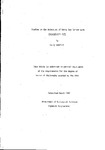Studies on the infection of honey bee larvae with Ascosphaera apis
| dc.contributor.author | Bamford, Sally | |
| dc.contributor.other | School of Biological and Marine Sciences | en_US |
| dc.date.accessioned | 2013-11-14T10:01:13Z | |
| dc.date.available | 2013-11-14T10:01:13Z | |
| dc.date.issued | 1987 | |
| dc.identifier | NOT AVAILABLE | en_US |
| dc.identifier.uri | http://hdl.handle.net/10026.1/2699 | |
| dc.description.abstract |
The fungus Ascosphaera apis causes the disease chalk brood in larvae of the honey bee, Apis mellifera. Ascospores were recognised as the agents of disease, but the site of their germination to initiate infection had not been established. In this study larval surface cuticle was initially investigated as a possible site, but spores did not even activate here. Therefore, potential inhibitors of spore germination were studied, including water and chloroform washings of larval cuticle; 4 larval food constituents - pollen, honey, brood food, royal jelly; and a variety of medium-chain fatty acids a t concentrations of 1, 0.1 and 0. 01%. Royal jelly exhibited a severe inhibitory effect on all germination stages. Larvae were successfully infected by feeding them food Containing A. apis spores, both in vitro and in vivo. A histological study of infected larvae demonstrated germination of spores in the mid-gut lumen, followed by penetration of the peritrophic membrane and gut epithelium by developing hyphae; and subsequent invasion of larval tissues by mycelia. Various aspects of spore physiology were investigated. Spore activation and enlargement were shown to be independent of temperature within the ranges of 10 to 40°C and 25 to 40°C respectively, while germ-tube production was closely temperature related, only occurring between 25 and 37°C - with an optimum between 31 and 35°C . However, all 3 germination stages were found to be independent of environmental pH within the range of pH 5 to 7.8. Studies on the nutritional requirements for germination revealed the need for exogenous supplies of both a carbon and nitrogen source to support germ-tube production. The ‘spore-ball phenomenon’ was investigated and a supplementary amino acid source was identified . The etiology of chalk brood is discussed in the light of these findings. | en_US |
| dc.language.iso | en | en_US |
| dc.publisher | University of Plymouth | en_US |
| dc.title | Studies on the infection of honey bee larvae with Ascosphaera apis | en_US |
| dc.type | Thesis | |
| plymouth.version | Full version | en_US |
| dc.identifier.doi | http://dx.doi.org/10.24382/3466 | |
| dc.identifier.doi | http://dx.doi.org/10.24382/3466 |
Files in this item
This item appears in the following Collection(s)
-
01 Research Theses Main Collection
Research Theses Main


